Tag: Program Notes
-

PROGRAM NOTES: EVGENY KISSIN
Frédéric Chopin and Robert Schumann “…calling it a sonata is a caprice if not a jest for Chopin seems to have taken four of his most unruly children and put them together possibly thinking to smuggle them, as a sonata, into company where them might not be considered individually presentable.” That’s the perceptive way Robert…
-

PROGRAM NOTES: CASTALIAN STRING QUARTET
Franz Joseph Haydn String Quartet in D, Op. 76 No. 5 Having recently returned from his hugely successful visits to England and been liberated from financial woes, Haydn composed a set of six String Quartets, Op. 76 which were commissioned by Hungarian Count, Joseph Erdödy in 1797. Deviating from more traditional forms and establishing a…
-

PROGRAM NOTES: ANDRAS SCHIFF PERFORMS BACH
J. S. Bach: Well-Tempered Clavier One of the monumental landmarks in the history of music, Bach’s Well-tempered Clavier (the WTC for short) has come to represent the “Old Testament” of the pianist’s repertory (Hans von Bülow) and his “daily bread” (Robert Schumann). “For more than 250 years,” states Davitt Moroney, “Das wohltemperierte Clavier has…

